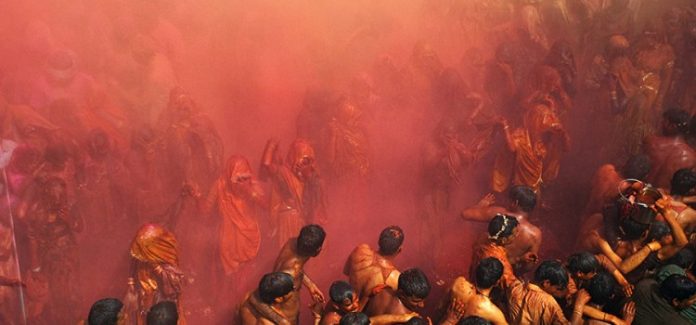The sleepy villages of Barsana and Nandgaon around Mathura and Vrindavan become hotbeds of activity during Holi. One sees overcrowded railway stations and bus stops, people crowding on rooftops, policemen valiantly trying to keep some semblance of order, street food of every kind– and colour, colour and more colour than one can ever imagine. The celebrations are grand at these particular places.
celebrations

Lathmaar Holi at Barsana and Nandgaon
It’s a woman’s world after all and the women of Barsana, a village near Mathura, prove it during this time. By tradition they beat up men of the neighbouring village, Nandgaon, with sticks, hence it’s known as Lathmaar (beating with sticks) Holi.

Banke Bihari Holi
Banke Bihari temple in Vrindavan is a huge attraction and is beautifully decked up for Holi. If you get to Barsana before Lathmaar Holi, then witness the unique laddoo Holi festivities in which sweets are thrown around and spiritual songs are sung.

Colourful Holi at Mathura and Vrindavan
Mathura is where Lord Krishna was born and Vrindavan is where he spent his childhood. The Sri Krishna Janmashtami in Mathura holds an interesting show in the week before Holi. The week-long celebrations at the Banke Bihari temple in Vrindavan are also legendary and culminate with the throwing of colours on Dhulendi.
Colourful processions also start from Vishram Ghat and finish near Holi Gate. It is best to catch the throwing of colours at Dwarkadheesh Temple in Mathura.
Huranga at Dauji temple
A day after Holi, the devotees look to Krishna’s elder brother, Balram to continue the festivities as ‘Krishna has left Mathura and returned to Dwarka after playing Holi’. Dauji Maharaj, as he is referred to, ruled this province called Dauji after him, around 30km from Mathura. Dauji ka Huranga starts with people gathering in the Dauji temple premises around noon. Holi Sangeet is sung to the idol as a form of taking permission to continue the revelry and play Holi in his town. If, till now, women had the upper hand in Holi celebrations, especially during Lathmaar, it is time for men to exact revenge and drench women in coloured water. The women try to save themselves by tearing off men’s clothes, dipping them in water and then beating them with the same. Huranga also marks the end of Holi celebrations in Brijbhoomi when women raise a flag and the priest of Dauji temple declares the festivities over.




